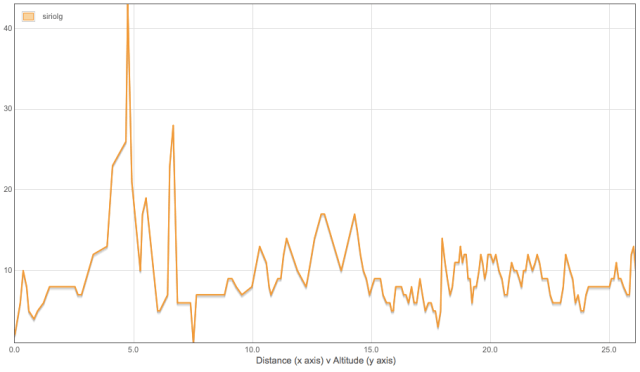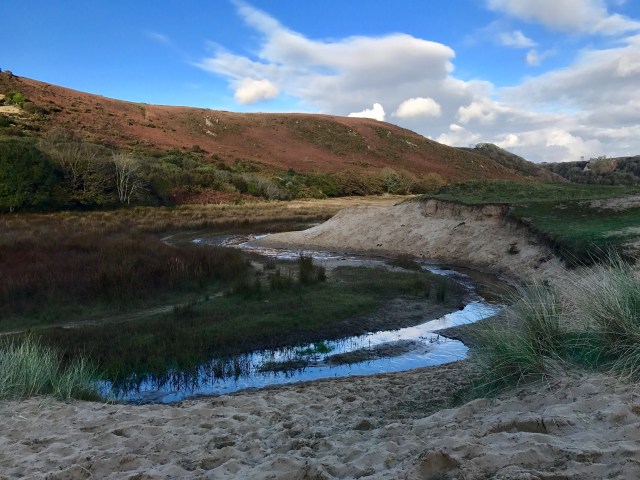
153. Y Barri (Barry) – Penarth

Distance: 10.87 miles
Max Altitude: 34 m
Min Altitude: 6 m
Height Gain: 129 m
Height Loss: 121 m
It was a bizarre foggy start to the day, a proper pea souper. I walked through the Knap shrouded in a mysterious gloom.
The tide was out and I considered walking across the bay to Barry Island but I didn’t fancy dealing with the sinking and soggy sand so I continued through parkland and then along Harbour Road. When I was little, driving down this road in the car meant you were seconds away from South Wales’ answer to Disneyworld, Barry Island Pleasure Park. Hot summer evenings, huge eyes, excitement, neon, the Log Flume, the wide-mouthed hippos on the jungle ride, clouds of candy floss, the ghost train, those red toffee dummy things on ribbons, the Waltzers, chips and fun. Happy days. But then Barry Island seemed to go a bit, well, rubbish, and people stopped going there. It went derelict and became nothing more than a fond childhood memory. However, a few years ago the life started to come back into it and it got a facelift finally. Before I got to the fair today though I had to walk towards Friar’s Point first.
The first thing I saw was this –
The mist was lifting slowly on Whitmore Bay.
Across the beach was Barry Island in all its glory.
I guess you can’t mention this place any more without mentioning ‘Gavin & Stacey’.

Despite the fact that many of the shops and eateries were shut, it still had that unmistakable vinegary smell of chips and sweet candy.
The promenade which, just a few years ago, had gone to look unkempt and depressing was clean and landscaped once more.
The happy memories were dashing in and out of my mind. I’m making it sound like I haven’t visited here since I was a kid. That’s not true of course. But today seemed to be more of a stroll down memory lane than usual. Maybe it was because I was so close to home. Maybe it was because I was walking through at the end of more than 1100 miles of hiking. Who knows.
And by the way, if you’re thinking of calling this big wheel ‘the Barry Eye’, forget about it. A certain tourist attraction in London is not happy about it.
On a hot summer’s day, the following view includes hundreds and hundreds of beachgoers who have flocked here from across South Wales. It’s bizarre to see it so quiet.

I continued along the renovated prom.

I reached the relatively new and supremely colourful beach huts.

And unlike certain beach huts in other areas of Wales, these ones only cost £10 for peak times. No more struggling to get your underwear on whilst trying to pin your towel to your chest with your chin.

There’s also this jolly traversing wall, which spells out ‘Ynys y Barri’ (in Welsh Barry get a definite article preceding it).
I was enjoying my walk a lot. And I was enjoying Barry Island. I genuinely think that this is the nicest seaside destination of its sort in Wales. It wasn’t ten years ago but it certainly is now.

Everywhere you look, an effort has been made and that’s great.
I was getting to Nell’s Point.

I climbed up the hill. I was headed for the house of Chris and Margaret, a couple I had met in Freshwater East. We had chatted for ages and I had promised to pop by on my way past.

I knocked the door and Chris answered. I had surprised him and he was pleased to see me. Soon, Margaret arrived back from her walking group and we had tea. After a lovely chat and catch up I was back on my way.
I rounded the island and overlooked the lighthouse (yay!) on the breakwater.

Oh, did I mention it was Halloween?

Soon I was on the other side of the fairground and underneath the not-Barry Eye.

And I spotted the rogue panda from earlier on. He seemed to have his own bamboo so I didn’t need to feed him.

From there I took the new road off the island and along the redeveloped waterfront.
It was cold but crisp.

I deviated from the official path and cut through the docks.
I was behind the Dow Corning works.
I love this road. On the surface it’s ugly but it offers a glimpse behind the scenes of the local maritime industry.

I had an ulterior motive to my move off route. Firstly, it would actually bring me back to the side of the water sooner, but moreover, my route would take me past one of my favourite buildings in South Wales – the former Sully Hospital, now known as Hayes Point. It was built in 1936 and originally housed tuberculosis patients before later becoming a psychiatric facility.
I was back on the side of the water, but not yet on the official Wales Coast Path. Looking across the bay I could see Ynys Sili (Sully Island).

I walked past Tŷ Hafan, the Welsh children’s hospice, and looked back. How I love this stretch of coastline. The Wales Coast Path rejoined me and I moved onwards.

Every few metres there were little bits and bobs showcasing the area’s heritage and history.



Ynys Sili or Sully Island is a tiny tidal island near Swanbridge. A pirate known as ‘The Night Hawk’ used the island as his base in the 13th century and it’s had its fair share smuggling too. In 2011, it was put up for sale for £1.25 million but was then reduced to just £95,000 due to lack of interest.

I popped into the Captain’s Wife pub for a quick drink before re-starting my hike.
There’s been an awful lot of coastal erosion in this neck of the woods, meaning that the Wales Coast Path has been re-routed to avoid the landslides.

My stopping point for the day was to be Trwyn Larnog (Lavernock Point). It was at this location that the very first wireless signals over open sea were sent by Guglielmo Marconito to Ynys Echni (Flat Holm). It said “ARE YOU READY”, followed by “CAN YOU HEAR ME”. The reply was “YES LOUD AND CLEAR”. Quite amazing really. And now there’s this caravan park here to mark the spot.
I stopped hiking with a heavy heart. Tomorrow would be the last day of my hike. This incredible adventure was almost at an end.
















































































































































































































































































You must be logged in to post a comment.